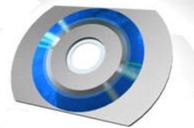 |
||
|
||
| ||
Give us a chance!Perhaps, if you have ever dealt with CD- or DVD-ROM drives, you noticed that in their trays there is a round hollow 80 mm in diameter. It is a place for a forgotten format of 80 mm CDs. The fact that it has not disappeared from a tray says that 80 mm discs is, yet, ISO-standard. What is this 80 mm CD? Let's check its characteristics. In the table you can see data on 120 mm 650 MBytes CD, for comparison.
I should note that 80 mm discs were developing little by little and thus reached a CD-R/RW stage. By the way, I have looked through sites of CD-R manufacturers and only on the Ritec's site I have found information on similar products, with record speed up to 12X, at that. However, I have learnt that you can order any variant of 80 mm CD-R/RW to the majority of companies.  This type of CD has its own little brothers. This is a family of so called "business card CD". In fact they are usual discs with two sides cut, so that they look like business cards. Their capacity varies from 20 to 60 MBytes depending of how much was cut off.  So, what can we see: 180 MBytes against 650 MBytes. The result is of course clear for everybody. Although 180 MBytes was a very good standard at the moment of its developing, multimedia technologies have made new requirements for data storage volumes. It resulted in the fact that 80 mm discs stepped aside from its elder brother - 120 mm CDs. The only thing that 80 mm discs can compete with is their size. But volume of data stored has won over the size. But now is coming an epoch of miniaturization and hyperintegration. And although 180 MBytes look not very attractive today, 80 mm discs still have a chance for renascence. Here matters a lot their compactness and price which is directly depend on the size (it concerns CD-R/RW to more extent). So, let's see what sphere 80 mm discs can occupy. MP3-playersDigital music format - MP3 and formats' family AAC are widespread and very popular all around the world. Initially, MP3-players used flash-memory as a main data carrier. But now you can see a lot of CD-players which play audio discs in MP3 format, and the more advanced models have also other formats. For players with flash-memory it's difficult to fight against the new-comers: 64-128 MBytes against 650 MBytes, and as for storage cost, you know that CD is a leader for a long time already. But a size of MP3-players based on a flash-memory is markedly less than that of the MP3/CD player: I can hardly call a CD compact. Therefore, you may see here 80 mm discs. 180 MBytes is quite good for storing MP3 and AAC music. Cost of the data storage will remain at the level of usual CD (maybe just a little higher), but compared with memory it is still much cheaper. And the first thing is compactness! If one would work out a player which would use only 80 mm CD, its dimensions would more than satisfactory. Moreover: it will be a serious challenge for MD-players. In fact, a 80 mm CD-MP3 player would inherit all possibilities of 120 mm CD-MP3 player, but it will be better as far as portability is concerned. China manufacturers have already introduced their variants of MP3-players for 80mm CD. Below you can see several models and their characteristics. AVC Technology Limited
|
|
Article navigation: |
| blog comments powered by Disqus |
| Most Popular Reviews | More RSS |
 |
Comparing old, cheap solutions from AMD with new, budget offerings from Intel.
February 1, 2013 · Processor Roundups |
 |
Inno3D GeForce GTX 670 iChill, Inno3D GeForce GTX 660 Ti Graphics Cards A couple of mid-range adapters with original cooling systems.
January 30, 2013 · Video cards: NVIDIA GPUs |
 |
Creative Sound Blaster X-Fi Surround 5.1 An external X-Fi solution in tests.
September 9, 2008 · Sound Cards |
 |
The first worthwhile Piledriver CPU.
September 11, 2012 · Processors: AMD |
 |
Consumed Power, Energy Consumption: Ivy Bridge vs. Sandy Bridge Trying out the new method.
September 18, 2012 · Processors: Intel |
| Latest Reviews | More RSS |
 |
Retested all graphics cards with the new drivers.
Oct 18, 2013 · 3Digests
|
 |
Added new benchmarks: BioShock Infinite and Metro: Last Light.
Sep 06, 2013 · 3Digests
|
 |
Added the test results of NVIDIA GeForce GTX 760 and AMD Radeon HD 7730.
Aug 05, 2013 · 3Digests
|
 |
Gainward GeForce GTX 650 Ti BOOST 2GB Golden Sample Graphics Card An excellent hybrid of GeForce GTX 650 Ti and GeForce GTX 660.
Jun 24, 2013 · Video cards: NVIDIA GPUs
|
 |
Added the test results of NVIDIA GeForce GTX 770/780.
Jun 03, 2013 · 3Digests
|
| Latest News | More RSS |
Platform · Video · Multimedia · Mobile · Other || About us & Privacy policy · Twitter · Facebook
Copyright © Byrds Research & Publishing, Ltd., 1997–2011. All rights reserved.